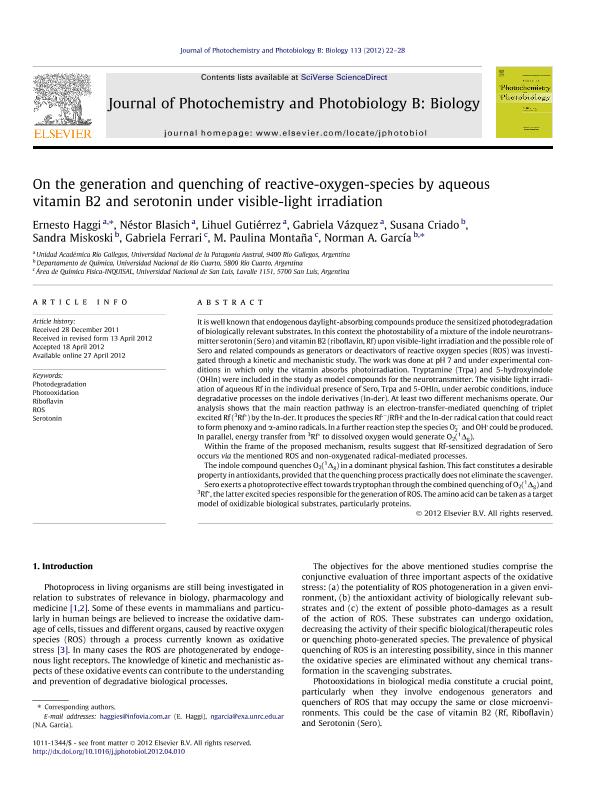Artículo
On the generation and quenching of reactive-oxygen-species by aqueous vitamin B2 and serotonin under visible-light irradiation
Haggi, Ernesto Sergio; Blasich, Néstor Fabian; Gutierrez, Lihuel Emiliano; Vazquez, Gabriela; Criado, Susana Noemi ; Miskoski, Sandra
; Miskoski, Sandra ; Ferrari, Gabriela Verónica
; Ferrari, Gabriela Verónica ; Montaña, Maria Paulina
; Montaña, Maria Paulina ; Garcia, Norman Andino
; Garcia, Norman Andino
 ; Miskoski, Sandra
; Miskoski, Sandra ; Ferrari, Gabriela Verónica
; Ferrari, Gabriela Verónica ; Montaña, Maria Paulina
; Montaña, Maria Paulina ; Garcia, Norman Andino
; Garcia, Norman Andino
Fecha de publicación:
04/2012
Editorial:
Elsevier Science Sa
Revista:
Journal of Photochemistry and Photobiology B: Biology
ISSN:
1011-1344
Idioma:
Inglés
Tipo de recurso:
Artículo publicado
Clasificación temática:
Resumen
It is well known that endogenous daylight-absorbing compounds produce the sensitized photodegradation of biologically relevant substrates. In this context the photostability of a mixture of the indole neurotransmitter serotonin (Sero) and vitamin B2 (riboflavin, Rf) upon visible-light irradiation and the possible role of Sero and related compounds as generators or deactivators of reactive oxygen species (ROS) was investigated through a kinetic and mechanistic study. The work was done at pH 7 and under experimental conditions in which only the vitamin absorbs photoirradiation. Tryptamine (Trpa) and 5-hydroxyindole(OHIn) were included in the study as model compounds for the neurotransmitter. The visible light irradiation of aqueous Rf in the individual presence of Sero, Trpa and 5-OHIn, under aerobic conditions, induce degradative processes on the indole derivatives (In-der). At least two different mechanisms operate. Our analysis shows that the main reaction pathway is an electron-transfer-mediated quenching of triplet excited Rf (3Rf) by the In-der. It produces the species Rf/RfH and the In-der radical cation that could react to form phenoxy and a-amino radicals. In a further reaction step the species O2 and OH could be produced.In parallel, energy transfer from 3Rf to dissolved oxygen would generate O2(1Dg). Within the frame of the proposed mechanism, results suggest that Rf-sensitized degradation of Sero occurs via the mentioned ROS and non-oxygenated radical-mediated processes. The indole compound quenches O2(1Dg) in a dominant physical fashion. This fact constitutes a desirable property in antioxidants, provided that the quenching process practically does not eliminate the scavenger. Sero exerts a photoprotective effect towards tryptophan through the combined quenching ofO2(1Dg) and 3Rf, the latter excited species responsible for the generation of ROS. The amino acid can be taken as a target model of oxidizable biological substrates, particularly proteins.
Palabras clave:
SEROTONIN
,
PHOTOOXIDATION
,
RIBOFLAVIN
,
REACTIVE OXYGEN SPECIES
Archivos asociados
Licencia
Identificadores
Colecciones
Articulos(CCT - CORDOBA)
Articulos de CTRO.CIENTIFICO TECNOL.CONICET - CORDOBA
Articulos de CTRO.CIENTIFICO TECNOL.CONICET - CORDOBA
Articulos(INQUISAL)
Articulos de INST. DE QUIMICA DE SAN LUIS
Articulos de INST. DE QUIMICA DE SAN LUIS
Citación
Haggi, Ernesto Sergio; Blasich, Néstor Fabian; Gutierrez, Lihuel Emiliano; Vazquez, Gabriela; Criado, Susana Noemi; et al.; On the generation and quenching of reactive-oxygen-species by aqueous vitamin B2 and serotonin under visible-light irradiation; Elsevier Science Sa; Journal of Photochemistry and Photobiology B: Biology; 113; 4-2012; 22-28
Compartir
Altmétricas



